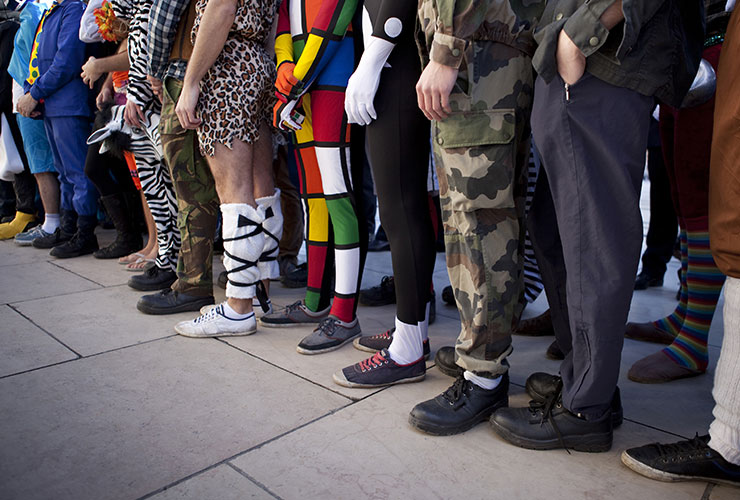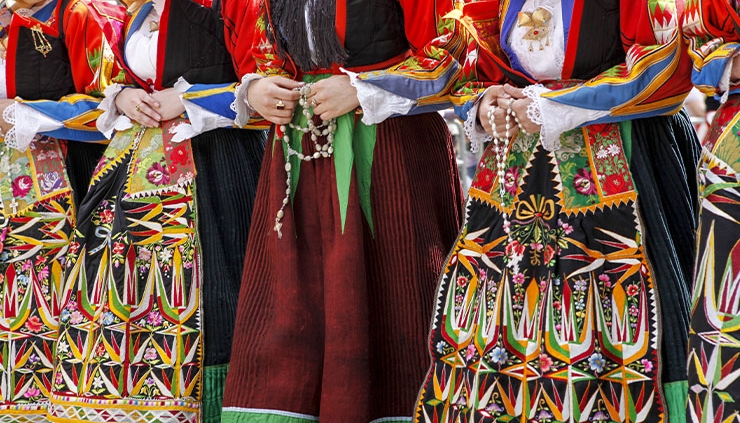Do you want to plan your next trip to Italy, but you don’t know when? Naturally, it’s always a good moment to visit the Bel Paese.
In Italy, each month has its appeal and holidays, both religious and public. For instance, Italian New Year’s celebrations or the 1st of May concert in Rome will ensure you unforgettable memories. However, if you love Italian culture and long for something unique I have what you need: an Italian festival.
What is an Italian festival?
An Italian festival usually honours the history, culture or the patron saint of an Italian city. Basically, these celebrations can last from one day to several days and involve a great deal of related events. In fact, by attending an Italian festival you will taste local food, listen to folk music and join traditional dances. Further, no matter when you decide to visit Italy, there will always be something going on somewhere. Basically, this is possible thanks to our ancient history and culture. Also, you could learn so much just by taking part in Italian festivals and folkloristic events, because they create a sense of community and provide roots to people’s identity.
So, let’s dig up what an Italian festival is about!
And I also suggest to you one of these Guides:
I selected for you 19 Italian festivals from North to South that will make you book the next flight to Italy.
So, let’s get started!
1. Historical Regatta, Venice
This Italian festival is perhaps the most important event of Venice, and includes rowing races and an historical parade.
Actually, the latter is the re-enactment of the welcoming given in 1489 to the wife of Cyprus’s King. In fact, she renounced her throne in favour of Venice.
Nowadays, the Historical Regatta (Regata Storica in Italian) takes place every first Sunday of September. Here, a colorful parade with 16th century-style boats and people in costumes crowd the Grand Canal, giving unforgettable sights.
2. Chess match, Marostica
Another fascinating Italian festival takes place on the second September weekend of the even years. Indeed, the town of Marostica, in the Veneto Region, is famous for its Chess Match (partita a scacchi in Italian).
Undoubtedly, it is something unique! In fact, people personificating chess pieces take the stage on the big marble chess board of Piazza Castello.
Also, more than 600 people in medieval costumes with horses, weapons and flags flood the streets. Truly, everything on this occasion contributes to creating a picturesque image.
3. Saint Peter’s Palio, Genoa
On June 29th the city celebrates Saint Peter with a captivating event: the Palio di San Pietro. This Italian festival originates from the city’s main source of income: fishing. In fact, fishermen used to rush to the shore in order to sell their fish before anyone else.
Briefly, it is a rowing competition between representatives of the Genoa’s rioni (boroughs). Then, after the sea-race, one of the boys runs toward the borough’s “castle” to put his pennant on it. Obviously, the first to do so is the winner.
Similarly to Venice Regatta, here people in costumes crowd the streets, making this event even more fascinating.
4. Explosion of the Cart, Florence
The Tuscan city of Florence has its own way to celebrate Easter Sunday. On this day, a cart packed with fireworks reaches the main square of the city. But most importantly, we are referring to a 30-foot-tall and antique cart!
In the meanwhile, a parade of hundreds of people in 15th century costumes accompanies it.Eventually, a dove-shaped flare lights the fireworks and a 20 minute spectacle begins.
Now, imagine being in front of the Duomo watching the air changing colours. It is quite something, right?
5. Florentine Soccer, Florence
The Florentine Soccer, or Calcio fiorentino in Italian, is probably the most important traditional event of the city. In short, this 16th century game is a mixture of soccer, rugby and wrestling and occurs in June.
Specifically, 4 teams with 27 players (dressed up in costumes) compete in 50 minutes’ matches. Of course, everything happens under the supervision of a main referee, 6 linesmen and a field master.
Then, the final match and a parade in medieval costumes take place on June 24th.
6. Siena’s Palio, Siena
This Italian festival occurs twice a year, on July 2nd and August 16th, in the city of Siena. In short, it consists of a horse race between the local contrade (districts) and parades in medieval costumes.
In this case, the prize is the palio, a rectangular hand-decorated piece of silk. However, it is important to notice that the winner is not the rider, but the horse.
And just one more thing: this traditional event is not simply a horse race. On the contrary, it is the culmination of secular rivalry between the contrade.
7. Battle of the Bridge, Pisa
This Italian festival takes place on the last Saturday of June in the Tuscan city of Pisa. Namely, the Gioco del Ponte (the Italian name of the event) is an historical re-enactment of an ancient game.
Before the game begins, 710 people in 14th century costumes parade in the streets. Then, the actual game starts: it consists in pushing a cart along a purposely installed track on Ponte di Mezzo.
8. The Saracen Joust, Arezzo
If you are fond of the Middle Age, then this Italian festival is what you’re looking for! Basically, la Giostra del Saraceno (Italian name of the event) is a re-enactment of the knights training.
Importantly, it takes place twice a year. First, on the last Saturday of June and then on the first Sunday of September. On these days, the 4 districts compete to win the 3 meters-long Golden Spear (actually made of wood).
Undoubtedly, it is a unique chance to dive into a medieval atmosphere, with local food, music and other spectacles.
9. Bravio delle Botti, Montepulciano
This Italian festival takes place in Montepulciano, a Tuscan town famous for its Nobile wine. The town’s connection to wine culture is also celebrated in its annual event known as “Bravio delle Botti”.
This festival is a barrel racing competition involving the town’s eight historical districts, known as contrade. Each contrada fields a team of two “pushers” who must push a heavy barrel along the steep and winding streets of the town all the way to the main square, Piazza Grande.
This festival has its roots in the Middle Ages, and until the end of the 17th century, it was a horse race. Later, it was transformed into the current and unique barrel race.
10. Race of the candles, Gubbio
This Italian festival called Festa dei Ceri (literally, feast of the candles) celebrates Saint Ubaldo on the 15th of May. Definitely, it is among the most ancient traditional Italian events.
Here, the word Ceri (candles) refers to the wooden structure on which people put the Saints’ statue. Incredibly, the total weight is more than 300 kg (661.387 pounds)!
On this occasion, men run carrying the statues of Saint Ubaldo, Saint George and Saint Anthony up to the cathedral. Obviously, the race is grueling but taking part in it is a great honour for everyone.
11. Calendimaggio, Assisi
The name of this Italian festival is almost impossible to translate. However, it is strictly entangled with pagan rituals and consists in an evocative welcoming to the upcoming spring.
In detail, celebrations occur on the Wednesday, Thursday, Friday and Saturday after the 1st of May. Also, on these days people organize historical re-enactments and games in costumes.
12. Quintana Joust, Foligno
This Italian festival is an historical re-enactment of medieval tournaments and happens twice a year. Indeed, it occurs on the 3rd Saturday of June while the rematch is on the third Sunday of September.
Obviously, the main attraction is the competition between the 10 districts of the city. However, what makes the Giostra della Quintana (Italian name) unique are the numerous events that revolve around it.
For instance, the typical parade in costumes or also the opening of the taverns that serve medieval food. Similarly, the ancient market represents an important phase of the celebrations as well as music and theater shows.
13. The Palio of the Archers, Gubbio and Sansepolcro
Likewise other events, the Palio degli Arcieri (Italian name) occurs twice a year. Precisely, on the first June’s Sunday in Gubbio and on the second September’s Sunday in Sansepolcro.
Historically, the competition roots back to the XV century and has never stopped since then. In short, it consists in hitting a target with a crossbow’s arrow from a distance of 36 meters.
Additionally, the game is played in an enchanting frame with people in medieval and Renaissance costumes.
14. Genzano Flower festival, Genzano
If you are in Rome at the end of June make sure to pop in Genzano for its Infiorata. Typically, this Italian festival celebrates the Corpus Domini, a catholic feast. On this occasion, artists ”paint” the main street with a flower carpet, covering a surface of 1890 m².
Logically, due to the flowers’ perishability the carpet is realized on the same day. Basically, artists draw the subject the night before and then colour it with flowers in the morning.
Really, the smell and the colours are something impossible to describe!
15. San Gennaro, Naples
The celebration of Saint Gennaro occurs on the 19th September and is probably the most heartfelt feast of Naples. Indeed, Neapolitans dedicate a wide range of events to the Patron Saint.
Notably, the most awaited moment is the liquefaction of the Saint’s blood. Even if this miracle happens 4 times in a year, the most important date is the 19th September.
Actually, if the miracle doesn’t happen, people believe that hard times will come. And historically speaking, it has always been true!
16. Lilies festival, Nola
Don’t let the name trick you! Flowers have nothing to do with this Italian folkloristic event. Conversely, the Gigli (Lilies in English) are wood and papier mâché obelisks.
However, this event celebrates St. Paolino on the Sunday after the 22nd June. And even if these gigantic Gigli are carried by hand in an exhausting procession, the excitement is palpable.
Then, add some Neapolitan music and magic happens. So, don’t be surprised If I tell you that in 2013 this Italian festival became Unesco Oral and Intangible Heritage.
17. Saint Efisio Festival, Cagliari
On the 1st of May Cagliari celebrates Saint Efisio organizing the most ancient and long Italian processions. Incredibly, it covers almost 65 km in only 4 days!
Additionally, almost 6 thousand people in traditional dresses take part in it. As they go, they sing folk songs and pray to the Saint. Now, imagine this colourful parade and the participants’ voices echoing in the Sardinian streets…goosebumps!
18. Sardinian Cavalcade, Sassari
The Calvalcata Sarda (Italian name) is an ancient folk festival that happens on the third Sunday of May. Basically, there are two major moments.
First, a parade of people in traditional dresses, literally gathering from all over the island. Second, the spectacle in the racecourse. Here, you will see acrobatic riding performances, dance shows and listen to traditional music.
19. The Sa Sartiglia, Oristano
This Italian festival relates to Carnival, as the word Sartiglia is its dialectical synonym. Basically, it is an ancient horse-riding event and one of the most spectacular Italian Carnivals.
Nowadays, it occurs at the end of February and includes a wide range of shows. Among the most important there are Medieval reenactments, jousts and other games in traditional costumes.
Also, this event has a precise and fixed schedule, which must be strictly followed.
20. Mysteries Procession, Trapani
This Good Friday’s procession is the Sicilian longest one, as it runs for more than 24 hours.
Practically, the procession features 20 floats, canvas and glue statues representing the crucial moments of Christ’s Passion. Obviously, the overall result is a vibrant and full of emotions atmosphere.
Conclusion

So, we have explored some of the coolest Italian festivals. But obviously there are still so many to discover!
Indeed, the diversity of Italian culture and the millenial history have provided an infinite source for festivals’ organization.
Clearly, as we said, they are not just a form of entertainment. Instead, they fuel the self awareness of our identity and ensure the strengthening of a sense of community.
Therefore, experiencing as many Italian traditional events as you can could be the best way to plunge into Italian culture.
So, from which Italian festival will you start?


